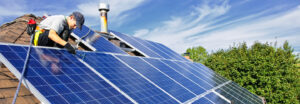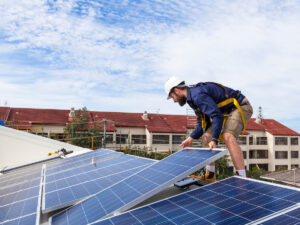Solar panels are renowned for their durability and long operational lifespan, making them a highly attractive investment for homeowners, especially in sun-rich regions like Arizona. On average, solar panels are designed to last between 25 to 30 years, but many continue to produce electricity beyond this period, albeit at a reduced efficiency. Understanding the factors that influence the lifespan of solar panels, particularly in a climate as unique as Arizona's, is crucial for anyone considering solar energy for their home.
Understanding the Typical Lifespan of Solar Panels in Arizona
- Quality of Solar Panels: The longevity of solar panels is largely determined by their quality and the technology used in their manufacturing. Panels from reputable manufacturers are built to withstand the test of time, typically accompanied by warranties that span 20 to 25 years. These warranties often guarantee that the panels will produce a specific percentage of their original capacity—usually around 80% to 90%—over the warranty period. Higher-end panels, while more expensive, often boast lower degradation rates and better resilience to environmental stresses, translating to a longer useful life.
- Arizona's Climate and Its Impact: Arizona's climate presents a double-edged sword for solar panels. On the one hand, the state enjoys abundant sunshine, which is ideal for maximizing solar energy production. On the other hand, the intense heat and high UV exposure can exert stress on the panels. However, it’s important to note that most modern solar panels are engineered to handle high temperatures and UV radiation. The materials used, such as tempered glass and advanced polymers, are designed to resist the wear and tear caused by prolonged exposure to harsh sunlight and heat. While the efficiency of solar panels can slightly drop during extremely hot days—known as a temperature coefficient—this effect is generally minimal and does not significantly impact the overall lifespan of the panels.
- Degradation Rate of Solar Panels: Solar panels, like all technologies, experience a gradual decrease in performance over time—a process known as degradation. The degradation rate refers to the percentage by which a solar panel's efficiency declines each year. For modern panels, this rate typically ranges from 0.5% to 1% annually. This means that after 25 years, a solar panel might still operate at about 75% to 87.5% of its original capacity. In the context of Arizona, where the panels receive an ample amount of sunlight, even with this natural degradation, they continue to produce a significant amount of electricity well beyond their warranty period. Advances in solar technology are continually pushing these degradation rates lower, ensuring that panels remain productive for as long as possible.
- Maintenance and Longevity: Proper maintenance is key to ensuring that solar panels achieve their maximum lifespan. In Arizona, one of the most common maintenance tasks involves cleaning the panels. The state’s dry climate can lead to the accumulation of dust, dirt, and debris on the panels' surface, which can reduce their efficiency by blocking sunlight. Regular cleaning, either by the homeowner or by a professional service, can help maintain optimal performance. Additionally, routine inspections of the entire solar power system—including the panels, inverters, and wiring—can identify potential issues early, such as micro-cracks in the panels or wear in the electrical components. Addressing these issues promptly can prevent minor problems from escalating into major ones, thereby extending the life of the system.
- Advancements in Solar Technology: The field of solar technology is rapidly advancing, with newer panels being designed to last even longer and perform better in a variety of conditions. Innovations in materials science, such as the development of more resilient encapsulants and back sheet materials, are improving the durability of panels. Additionally, improvements in manufacturing techniques are leading to panels with lower degradation rates and greater resistance to environmental stresses like high temperatures, UV exposure, and humidity. For homeowners in Arizona, this means that installing solar panels today could offer even longer-lasting performance compared to systems installed just a decade ago.
- Real-World Performance: While the average lifespan of solar panels is often quoted as 25 to 30 years, it’s important to recognize that many panels continue to function well beyond this timeframe. Studies and real-world data have shown that solar panels can still produce electricity after 30 or even 40 years, though at reduced efficiency. In Arizona, where solar radiation levels are high year-round, the panels will continue to generate a substantial amount of electricity, contributing to lower energy bills and greater energy independence for homeowners. The extended life of these panels, combined with the relatively low maintenance costs, underscores the long-term financial and environmental benefits of investing in solar energy.
- Inverters and Other System Components: While the panels themselves are highly durable, it’s also important to consider the lifespan of other system components, particularly the inverter. The inverter, which converts the direct current (DC) electricity produced by the panels into alternating current (AC) electricity used by your home, typically has a shorter lifespan than the panels, averaging around 10 to 15 years. In Arizona, the high temperatures can potentially shorten the lifespan of inverters if they are not properly ventilated or installed in a shaded area. Homeowners should plan for at least one inverter replacement during the life of the solar panel system. Ensuring that the inverter is regularly maintained and protected from extreme heat can help extend its operational life.
In summary, solar panels installed in Arizona typically last 25 to 30 years, but with proper care and maintenance, they can continue to produce electricity well beyond this period. The high-quality panels designed for durability, combined with Arizona's abundant sunshine, make solar energy a particularly wise investment in this region. Although the panels will experience some efficiency loss over time, their ability to generate clean, renewable energy remains significant even after decades of use. By investing in regular maintenance and staying informed about technological advancements, homeowners in Arizona can maximize the lifespan and efficiency of their solar power systems, ensuring long-term energy savings and a reduced carbon footprint.

Monday - Friday 7AM to 5PM
Saturday - by appointment only
We proudly serve Green Valley, Marana, Oro Valley, Saddlebrooke, Sahuarita, Tucson, Vail, and the surrounding areas.


